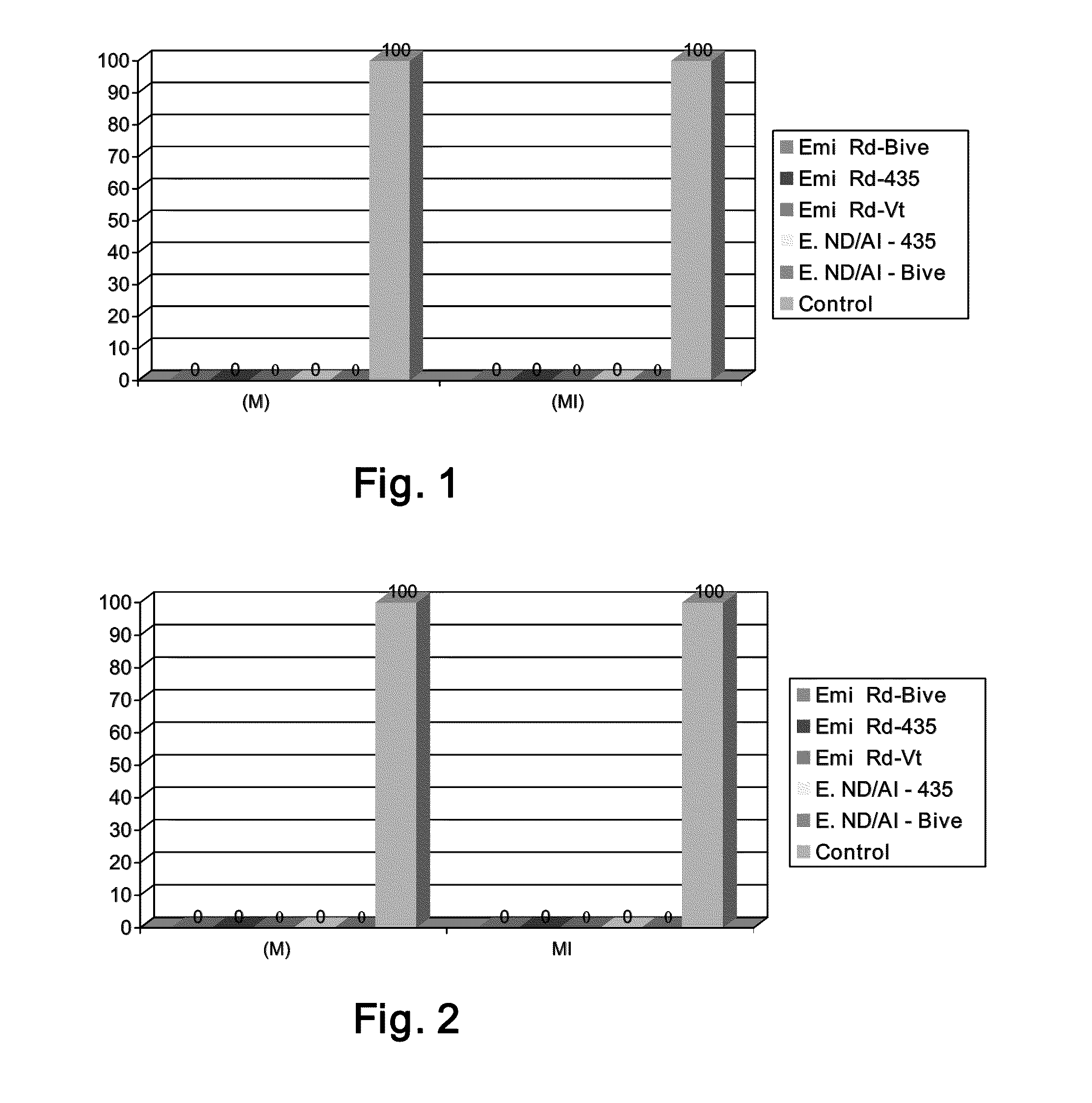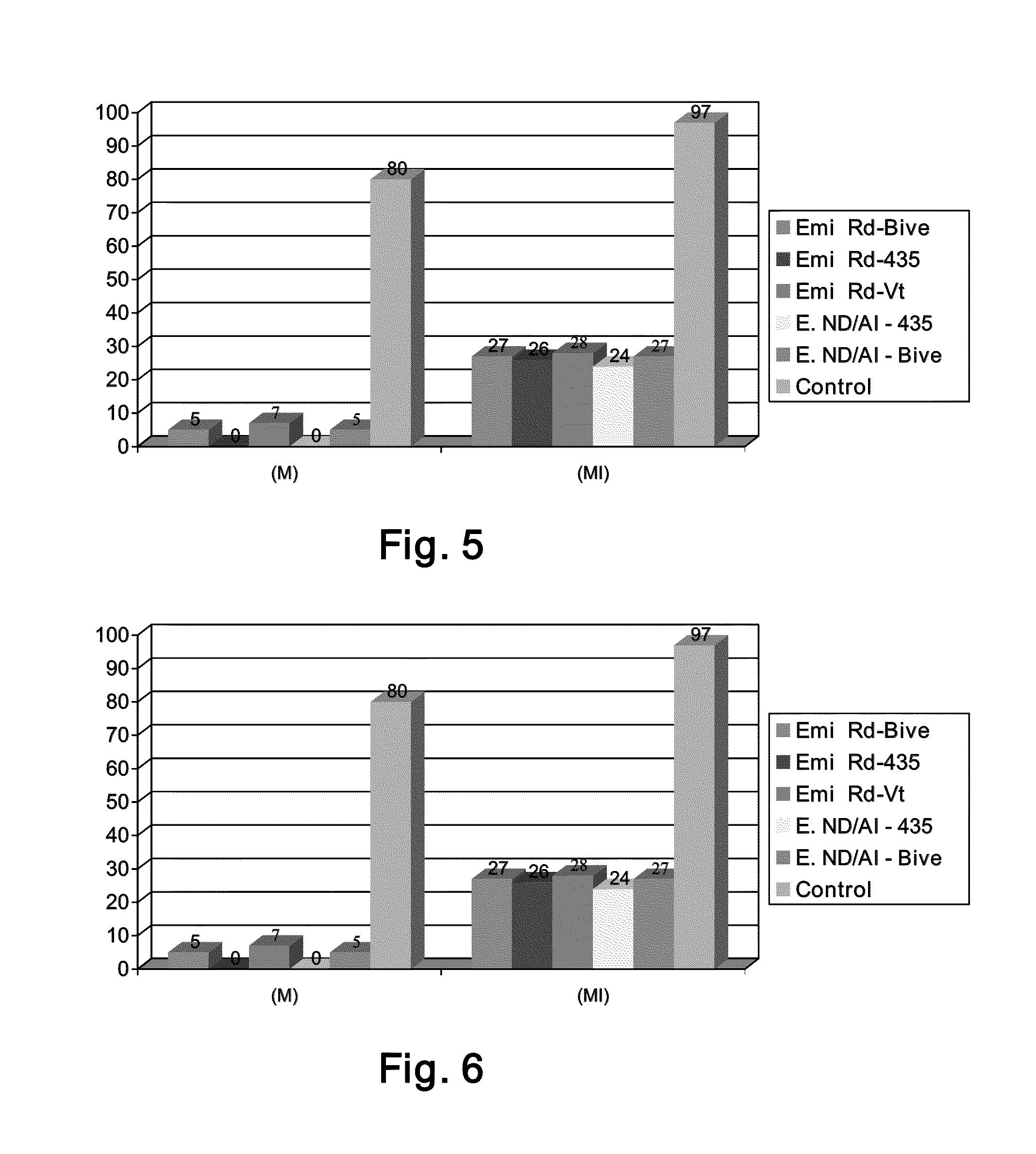Recombinant inactivated viral vector vaccine
a technology of inactivated viral vector and vaccine, which is applied in the direction of bacterial antigen ingredients, material testing goods, biochemistry apparatus and processes, etc., can solve the problems of high morbidity and mortality, difficult application of large-scale aviculture and limited stability of emulsified active vaccines. , to achieve the effect of reducing the excretion of field-type viruses and reducing the spread of viruses
- Summary
- Abstract
- Description
- Claims
- Application Information
AI Technical Summary
Benefits of technology
Problems solved by technology
Method used
Image
Examples
example 1
Production of the Newcastle-LaSota Vector
In order to clone the Newcastle-virus LaSota-strain genome and thereby producing a viral vector, firstly, an intermediate vector called “pNDV / LS” was produced. A total viral RNA extraction was carried out for the Newcastle-LaSota strain by the triazole method. The cDNA (complementary DNA) synthesis was made from the purified RNA of the viral genome, using the previously purified total RNA as a template. With the purpose of cloning all genes from the Newcastle genome (15, 183 base pairs (bp)), 7 fragments having “overlapping” ends and cohesive restriction sites were amplified by PCR. Fragment 1 (F1) comprises from nucleotide (nt) 1-1755, F2 from nt 1-3321, F3 comprises from nt 1755-6580, F4 from 6,151-10,210, F5 comprises from nt 7,381-11,351, F6 from 11,351-14,995 and F7 comprises from nt 14,701-15,186. The assembly of the 7 fragments was carried out in a cloning vector called pGEM-T using standard linking techniques, thereby rebuilding the N...
example 2
HA-Gene Cloning from AIV Subtype H5N2 435 Strain 435
Total viral RNA extraction was carried out to clone the HA-gene of AIV 435 strain by the Triazole method. This purified total RNA was used later to synthesize cDNA (complementary DNA), and by the PCR technique, the HA-gene from AI virus was amplified using specific oligonucleotides. The HA gene from 435 was then inserted into the pGEM-T vector, using standard cloning techniques and producing the plasmid: p-GEMT-435.
example 3
HA-Gene Cloning of AI 435 within SacII Site of pNDV / LS Vector to Produce Plasmid: pNDV / LS-435
A. Intermediate pSacIIGE / GS Vector Production:
A new intermediate vector called pSacIIGE / GS was built to introduce transcription sequences from Newcastle called GE / GS at 5′ end of the HA 435 gene, by the PCR initial amplification of sequences GE / GS, taking the Newcastle genome as a template and the later insertion of these sequences in pGEM-T.
B. HA-Gene Subcloning to pSacIIGE / GS Vector:
Plasmid pGEMT-435 was digested with HpaI-NdeI and further cloned into pSacIIGE / GS, to produce plasmid pSacIIGE / GS-HA435.
C. Subcloning of GE / GS-HA435 to pNDV-LS Vector
Both plasmids: pSacIIGE / GS-HA435 and pNDV / LS, were digested with SacII, the digestion products were purified and the GE / GS-HA435 region was purified and inserted into SacII site of pNDV / LS, thereby producing the infective clone called: pNDV / LS-435.
PUM
| Property | Measurement | Unit |
|---|---|---|
| pH | aaaaa | aaaaa |
| pH | aaaaa | aaaaa |
| concentration | aaaaa | aaaaa |
Abstract
Description
Claims
Application Information
 Login to View More
Login to View More - R&D
- Intellectual Property
- Life Sciences
- Materials
- Tech Scout
- Unparalleled Data Quality
- Higher Quality Content
- 60% Fewer Hallucinations
Browse by: Latest US Patents, China's latest patents, Technical Efficacy Thesaurus, Application Domain, Technology Topic, Popular Technical Reports.
© 2025 PatSnap. All rights reserved.Legal|Privacy policy|Modern Slavery Act Transparency Statement|Sitemap|About US| Contact US: help@patsnap.com



